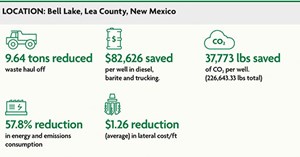WBM provides clean solutions, time and money savings in head-to-head tests against NAF
The Permian basin has always been an area where new developments in the oil industry are discovered, tested and tried. The most recent success story out of the Permian resulted in an operator realizing a savings of over $80,000 per well in trucking costs; a 57.8% reduction in energy and emissions consumption; almost 10 tons of waste haul-off eliminated; and five days of drilling time saved per well, simply by switching from an oil-based mud to a high-performance water-based mud (HPWBM).

The need to improve drilling economics, efficiencies, and environmental stewardship has never been more at the forefront of the industry than now. To address these issues, an engineered approach to deliver high-performance drilling and environmental excellence was recently implemented on a series of Wolfcamp horizontal wells, using a unique high-performance water-based mud from Newpark Fluids Systems.
Located throughout the Permian basin, the Wolfcamp formation has seen crude production increase significantly over the past decade. The area is now responsible for almost one-third of the total production in the Permian basin. In addition to that, the oil and gas industry’s evolution toward clean, sustainable wellsite practices, combined with longer lateral intervals and a necessity to deliver wells faster and more economically, has created unique challenges for the drilling fluids used in well construction.
Oil and gas advances in the Wolfcamp have been the primary drivers, resulting in increased production over the past decade. In the past, development wells had been drilled with vertical trajectories but they have since transitioned to more aggressive horizontal profiles. The significant increase in crude production from the Wolfcamp is an outcome resulting from this transition toward horizontal drilling, coupled with increased lateral lengths and optimized completions.
Challenge. Non-aqueous drilling fluids (NAF) had become the fluid-of-choice for drilling Wolfcamp horizontal wells, due to apparent better performance related to increased rates of penetration and reduced torque and drag. But an increase in the amount of gas influxes, frequency and severity of lost circulation events and water flows in the Wolfcamp have increased the risks associated with use of NAF. It became clear that a better solution had to be found.
Solution. In a departure from conventional practices, the operator utilized an engineered approach to deliver high-performance drilling, coupled with environmental excellence in Wolfcamp horizontal wells through use of Newpark’s Nviros HPWBM. Use of the HPWBM resulted in improved well economics, as well as records set in drilling performance, including footage per day and days to drill the lateral sections, Fig. 1.
To start, a performance baseline was established and then used to compare the operational performance of use of non-aqueous fluids and HPWBM in the Wolfcamp wells. All the wells in the program were drilled to a similar depth, and they targeted the same Wolfcamp production zone. When using NAF, the operator was averaging 20.3 days from spud to release of the rig on a typical Wolfcamp horizontal well, averaging 1,061.2 ft/day overall, and 787.3 ft/day in the lateral section. These well metrics were comparable to offset wells drilling similar lateral lengths and production targets in the surrounding county.
The challenges of drilling extended-reach Wolfcamp shale laterals demanded a fluid that provided a high level of torque and drag reduction (lubricity), hole cleaning, along with a stable wellbore. As a result, the selection process for drilling fluids is critical to project success.
As the oil and gas industry strives for advanced standards for environmental impact, health and safety, and continually aims to reduce costs and improved efficiencies, the development and use of advanced polymer chemistry has provided an alternative to the traditional NAF systems. Previous water-based mud systems had limitations that prevented their use in certain conditions: 1) high monovalent salinity; 2) high total hardness (Ca++/Mg++); 3) produced water; and 4) divalent salinity. Newpark’s advanced polymer chemistry overcomes those prior limitations, as well as outperforming and simplifying fluid formulations.
Comparing apples to apples. Using a total of 12 wells with virtually identical characteristics, the operator drilled six using traditional NAF, and six with Newpark’s Nviros high-performance water-based mud. Nviros is an enhanced formulation built upon the company’s legacy of innovative water-based drilling fluid systems, and incorporates Ntegral polymers together with Evolube G lubricant at a 1%-2% concentration designed for extended-reach drilling applications.
As a water-based mud, Nviros enabled the operator to save on the disposal costs, logistics, base-fluid costs, motor realign fees, and pit cleaning expenses associated with oil-based mud. Consequently, it allowed the operator to create a greener, cleaner, and leaner operation that got them to total depth significantly faster.
Because Nviros was prepared by mixing non-hazardous materials supplied in sacks at the wellsite, it dramatically reduced the amount of drum or tote cleaning, as well as the quantity of waste destined for a landfill. It also significantly cut the number of drilling days, which in turn reduced the energy consumption and CO2 emissions from the operation.
ESG compliance. According to Newpark’s V.P. for Drilling and Completion Fluids, Billy Dye, “the Wolfcamp project was significant, because it was a direct comparison over a number of wells of a water-based mud and an oil-based mud. There were 12 wells drilled from the same rig. It was a unique opportunity, because typically, when we’re comparing water-based performance against oil-based, it’s always one being drilled with rig A, and one with rig B, or they are separated by several miles. In this instance, having the same rig, the same crew, the same drilling engineers, the same drilling foreman, and the same well profile allowed us to compare apples to apples.”
Because of the industry’s increased attention to environmental, social and governance (ESG) strategies, the use of a HPWBM is integral in complying with the operator’s plans. Ntegral is a specialized polymer that performs three critical functions: viscosity, cuttings encapsulation and fluid loss control. The number of products required to achieve the key fluid properties is simplified, and this thereby supports the operator’s safety and ESG initiatives by taking trucks off the road (Table 1) and reducing the number of lifts by rig site workers.
In addition, the polymer is innovative and unique in its ability to form a non-invasive, thin pliable filter cake, as well as its shear-thinning rheological properties. The versatile polymer lays down a thin filter cake that is highly lubricious, which reduces the risk of stuck pipe and improves drilling efficiency. The polymer also improves resistance to contamination and minimizes reactivity to calcium or divalent ions.
Make it sustainable. Newpark is advancing its sustainability position by paying close attention to environmental impacts of its products and services. One focus of this is through the increased use of plant-based chemistries that do not sacrifice performance and are characterized as renewable resources. The performance of polymers is not affected by high salinity or hardness, and their use in field brines and produced water is possible. Key performance attributes of the new polymer include: 1) multi-functional (filtration, viscosity, encapsulation); 2) plant-based, sustainable chemistry; 3) readily dispersible and easy-to-mix in freshwater or saturated brines; 4) provides non-progressive gels; 5) chemically stable to contaminants; and 6) thermally stable to 250°F in fresh water.
Less waste, less diesel. In addition to the chemical advantage, there is also a benefit from the human aspect. “From an ergonomic standpoint,” Dye said, “this is better for the workers on the rig, because there are no drums and there are fewer products to forklift around, so they aren’t inhaling diesel fumes or running the risk of back injuries. From a logistics aspect, there are less trucks on the road, which in the case of the Wolfcamp job, meant only 2,157 lb of waste to be hauled off to a landfill using Nviros, as compared to 21,450 lb, using the oil-based mud.”
Specifically, the Nviros HPWBM used 1,090 50-lb sacks and 1,462 25-lb sacks, while the oil-based mud used 3,684 50-lb sacks and 228 100-lb sacks. In addition, NAF required 222 Hazmat drums versus none for Nviros. Finally, 239 pallets were required for NAFand only 86 for Nviros.
From the environmental standpoint, again, in a head-to-head against NAF, using Nviros saved 37,773 lb of CO2 per well, a total of over 225,000 lb for the six wells using HPWBM. And Nviros required no diesel, while the NAF used over 104,000 gal., resulting in a savings for the operator of almost $300,000 at the then price of $2.80 per gal. of diesel, much less than today’s price, Table 2. All these things helped reduce the average lateral cost by $1.26/ft.
PLONOR validation. One of the most impressive results to come out of the Wolfcamp tests is the fact that the HPWBM chemistry and the use of Nviros has been validated as posing little or no risk to the environment (PLONOR). This acronym, as well as what it stands for, is not just an American acronym, but it is an accepted standard worldwide. And since the environmental sensitivities are greater on an international scale, the use of an HPWBM takes on a whole new world of applications from a global standpoint. “The operator we worked with in Wolfcamp said that he has always disliked the use of oil-based muds for a variety of reasons, and after the results of our head-to-head testing, he said he’s never going back to using NAF. That is a real inflection point, not only for his company, but for the industry as well,” Dye concluded.
CONCLUSION
The use of Nviros HPWBM with the new polymer chemistry exceeded the operator’s expectations in reduction of operational time and expense. Below is a summary of the results:
- A 15.29% reduction in cost/ft in the lateral section, from $9.89/ft to $8.38/ft.
- Average drilling days in lateral section (KOP to TD) reduced 58.32%, from 13.39 days to 5.58 days.
- Average fluids cost/ft reduced by 29%, from $8.72 to $6.21.
- Average total days on well reduced by 37.44%, from 20.26 days to 12.68 days.
- Average ft/day increased 32.31%, from 1,061.21 ft/day to 1591.18 ft/day, from spud to TD.
- Average ft/day in lateral section (KOP to TD) increased 52.58%, from 787.10 ft to 1,659.88 ft.
- Average of 7.59 days saved, compared to the traditional fluid strategy. Approximate AFE savings of over $546,135 per well, based on a daily spread rate of $72,000.
- A reduction in fluids costs of 53.18%.
- Record well drilled in 10.1 days, spud to TD, and 11.7 days, spud to rig release, on a four-string 20,000-ft± TMD Wolfcamp horizontal well.
- Reduction in diesel consumption of approximately 33,600 gal/well @ $2.54/gal is a savings of $85,344/well.
- HPWBM does not require a motor realignment like NAF, a savings of $9,000/motor x two motors is $18,000 in savings.
- HPWBM is built on location, while NAF is shipped from the mud plant, and trucking charges average approximately 18 loads x 5 hr/load x $125/hr equals $11,250 in savings.
- Added costs of NAF include NAF cuttings disposal, rig hand bonuses, pit cleaning, and truck washouts.
- HPWBM is designed to be safe for the environment, adhering to government regulations and ESG requirements.
- Multi-functional polymer chemistry provides cuttings encapsulation, filtration control and viscosity.
- Environmentally responsible—smaller footprint on location. Reduced product and barite consumption equate to less trucking impact on cost and the environment.


- Coiled tubing drilling’s role in the energy transition (March 2024)
- Shale technology: Bayesian variable pressure decline-curve analysis for shale gas wells (March 2024)
- Digital tool kit enhances real-time decision-making to improve drilling efficiency and performance (February 2024)
- E&P outside the U.S. maintains a disciplined pace (February 2024)
- U.S. operators reduce activity as crude prices plunge (February 2024)
- Drilling advances (January 2024)




